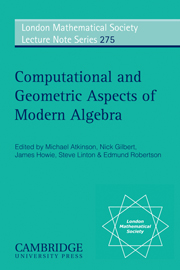Book contents
- Frontmatter
- Contents
- Foreword
- Participants
- 1 Lie Methods in Growth of Groups and Groups of Finite Width
- 2 Translation numbers of groups acting on quasiconvex spaces
- 3 On a term rewriting system controlled by sequences of integers
- 4 On certain finite generalized tetrahedron groups
- 5 Efficient computation in word-hyperbolic groups
- 6 Constructing hyperbolic manifolds
- 7 Computing in groups with exponent six
- 8 Rewriting as a special case of non-commutative Gröbner basis theory
- 9 Detecting 3-manifold presentations
- 10 In search of a word with special combinatorial properties
- 11 Cancellation diagrams with non-positive curvature
- 12 Some Applications of Prefix-Rewriting in Monoids, Groups, and Rings
- 13 Verallgemeinerte Biasinvarianten und ihre Berechnung
- 14 On groups which act freely and properly on finite dimensional homotopy spheres
- 15 On Confinal Dynamics of Rooted Tree Automorphisms
- 16 An asymptotic invariant of surface groups
- 17 A cutpoint tree for a continuum
- 18 Generalised triangle groups of type (2, m, 2)
5 - Efficient computation in word-hyperbolic groups
Published online by Cambridge University Press: 06 July 2010
- Frontmatter
- Contents
- Foreword
- Participants
- 1 Lie Methods in Growth of Groups and Groups of Finite Width
- 2 Translation numbers of groups acting on quasiconvex spaces
- 3 On a term rewriting system controlled by sequences of integers
- 4 On certain finite generalized tetrahedron groups
- 5 Efficient computation in word-hyperbolic groups
- 6 Constructing hyperbolic manifolds
- 7 Computing in groups with exponent six
- 8 Rewriting as a special case of non-commutative Gröbner basis theory
- 9 Detecting 3-manifold presentations
- 10 In search of a word with special combinatorial properties
- 11 Cancellation diagrams with non-positive curvature
- 12 Some Applications of Prefix-Rewriting in Monoids, Groups, and Rings
- 13 Verallgemeinerte Biasinvarianten und ihre Berechnung
- 14 On groups which act freely and properly on finite dimensional homotopy spheres
- 15 On Confinal Dynamics of Rooted Tree Automorphisms
- 16 An asymptotic invariant of surface groups
- 17 A cutpoint tree for a continuum
- 18 Generalised triangle groups of type (2, m, 2)
Summary
Abstract. We describe briefly some practical procedures for computing the various constants associated with a word-hyperbolic group, and report on the performance of their implementations in the KBMAG package on a number of examples. More complete technical details will be published elsewhere.
INTRODUCTION
During the mid 1980's, there was a growing demand for efficient computational methods for solving some of the classical decision problems, such as the word, conjugacy and isomorphism problems, in infinite finitely presented groups. These are of course theoretically undecidable in general, but some of them have been proved to be solvable in various special classes of groups, such as braid groups, Coxeter groups and knot groups. At that time, the only existing general technique for attempting to solve the word problem on a computer was the Knuth-Bendix algorithm (see, for example [Gilman, 1979]). However, this was not really satisfactory, because most of the time it did not work, and making it work at all for infinite groups usually depended on an appropriate and often non-obvious choice of an ordered generating set for the group.
In 1985, the concept of an automatic group was introduced by Thurston, as a formulation in terms of finite state automata of various geometrical properties of discrete cocompact groups of isometries of hyperbolic space that had been proved by Jim Cannon in [Cannon, 84]. Many familiar classes of groups, including word-hyperbolic groups, virtually abelian groups, Coxeter groups, braid groups and most knot groups have been shown to be automatic. The word problem is solvable (by reduction of words to a normal form) in quadratic time in these groups.
- Type
- Chapter
- Information
- Computational and Geometric Aspects of Modern Algebra , pp. 66 - 77Publisher: Cambridge University PressPrint publication year: 2000
- 1
- Cited by



